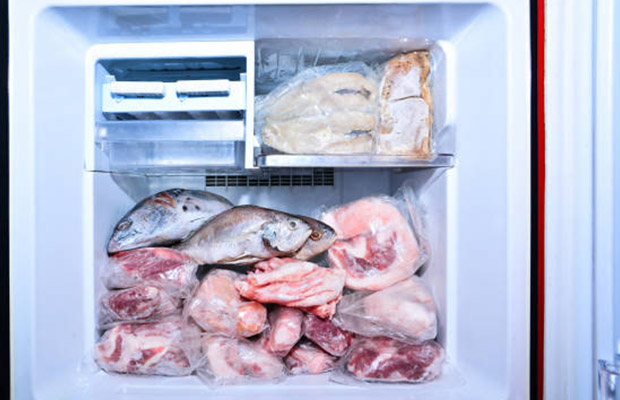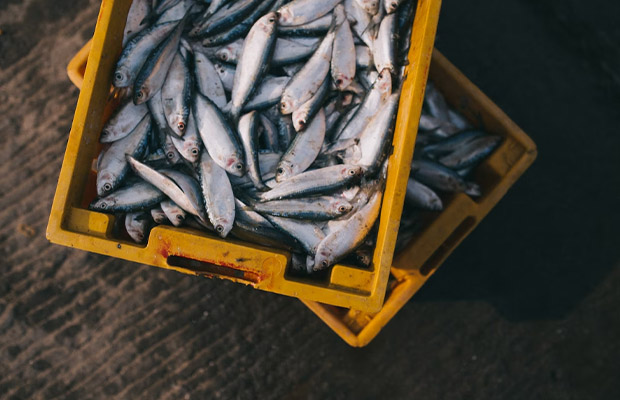Before you actually make your fish fillets, do you know where should you store raw fish in a refrigerator? Raw meats and fish should always be stored toward the bottom of your refrigerator, under ready-to-eat and prepared foods. You can find more advice on fish storage in this article.
A healthy homemade meal option is always fish. At least two hours after purchase, fresh fish needs to be cleaned right away and kept in a cold environment.
Keep reading, as I am going to provide you with more information on how to store raw fish safely and effectively. Raw fish should be stored in a way that prevents refrigerator odors and extends the life of their delicious flavors.
Table of Contents
Where Should You Store Raw Fish in a Refrigerator?
The position of your raw fish is very important when you’re trying to store properly and keep other food from being contaminated. The back of the fridge is a good place for it, as are some of the drawers, but it’s also important that you keep raw fish near the bottom of your fridge.

This fridge layout is based on the required heat processing of the foods stored in the refrigerator. The general rule is to place foods that require more extensive cooking at the bottom of the shelf and ready-to-eat and prepared foods at the top.
Additionally, because no ready-to-eat food will undergo further processing, this arrangement prevents meat juices from dripping onto any such food. Preventing unnecessary contact with foods inside the refrigerator is part of proper food safety practices.
Read More: Does Baileys Need to Be Refrigerated?
What Are the Storage Requirements for Fish?
When storing fresh fish, the two major requirements to keep fish safe and fresh are proper storage temperature and maximum storage time. The stability of the fish and its suitability for use in various dishes can be determined by these two requirements.
You must take into account the proper placement of fish products in original packaging in addition to these requirements. This is done to stop products that are stored next to fish from becoming contaminated.
Fish must be stored at a minimum temperature of 40°F (4°C) or lower to remain safe and fresh. Within two days of purchasing it from the fish market and after storage, the fish can be eaten at its best under these conditions. The storage temperature, a crucial component of food safety, must be continuously monitored by food workers.
The fish can be kept for three months in a freezer at 0°F (-18°C), provided it is stored correctly in a dry container with no additional water. Seafood that has been frozen and stored in airtight containers is more stable than seafood that has been refrigerated. Keep in mind that the maximum storage period will depend on the consistency of the storage temperature and the suitability of the container used to store the raw materials.
How Long Can Raw Fish Stay in the Fridge?
Fresh fish should only be kept in the refrigerator for a maximum of two days before cooking, according to general advice. After this point, you must determine whether the fish is still suitable for consumption or still possesses desirable qualities.
The danger in keeping raw fish in the fridge is that the temperature is not low enough to fully stop the growth of the majority of pathogenic microorganisms. Prolonged storage will cause the fish’s quality to continue to decline and may even raise the possibility of food poisoning.
How Long until Raw Fish Goes Bad?
Fresh fish, if cleaned and stored properly, can keep for up to two days in the refrigerator. In the freezer, clean fish can keep for up to three months if it is contained.
These estimated shelf-life times depend on how consistently the ideal storage temperature is maintained. To reduce the risk of bacterial and other pathogen contamination, food handlers must receive training on the ideal temperatures for raw fish as well as how to take corrective action when necessary.
How Long Can You Keep Raw Salmon in the Fridge?
It is advised to keep raw salmon and other fish in the refrigerator for no longer than two days because they go through several cleaning and transport stages. The raw salmon must be cleaned, dried, and refrigerated right away after purchase until use. Salmon can only be used after the second day with the manager’s or a trained employee’s permission.
Where Should Fish and Seafood Be Stored in a Restaurant?
In a restaurant or other food establishment, raw, fresh fish and common seafood must always be kept in a commercial refrigerator or walk-in freezer. Always place beef and pork above fish and raw seafood, keep them contained, and place them below ready-to-eat food and vegetables. Seafood must be thoroughly cleaned and kept in a sanitized container in order to keep it fresh for the longest period of time in the refrigerator.
Can You Freeze Fresh Fish?
In fact, fresh fish can be frozen. You must make sure that the fish you purchase is fresh and devoid of questionable characteristics before teaching food handlers how to store fish in the freezer. The fish should then be wrapped in plastic, aluminum foil, or placed in an airtight container. Fish should not be placed in the refrigerator unattended because it may come into contact with other foods. Compared to fatty fish, fresh, lean fish can be frozen for up to 9 months.
Why is Correct Raw Fish Storage Important?
Fish is renowned for having tender meat that can be prepared in a variety of ways. Despite this, fish, even when purchased from a seafood market, can easily spoil if not purchased fresh and stored correctly and promptly.
Fish is in direct contact with water, where most foodborne illnesses are transmitted. Fish must be properly stored and cooked to the right internal temperature to avoid giving consumers food poisoning.
Fish can spoil due to harmful bacteria or enzymatic reactions. When fish is kept in a cold environment, both potential causes of spoilage can be greatly reduced or even avoided.
Raw fish is regarded as a highly perishable food and needs to be handled carefully to keep it safe and fresh. Even in transit, it can quickly go bad. The refrigeration will help keep fish fresher longer when kept there. Therefore, when handling fish, controlled-temperature storage is always advised.
Read More:
How Do You Preserve Fish Without Refrigeration?
Without refrigeration, raw or fresh fishcan sit at ambient temperature for a maximum of two hours. Any foodborne illness is exponentially more likely to spread after this point. The most vulnerable groups are those with weakened immune systems, such as elderly people, pregnant women, and children under the age of five. Are there any additional methods you could use to preserve your fish if your refrigerator is already full? Luckily, there are!
Here are some ways that you could prolong or even improve the quality of your fresh fish in a restaurant without refrigeration:
- Use an ice chest to store and preserve your fish if your refrigerator breaks down or needs maintenance. Your ice chest’s capacity will determine how long it can keep the temperature stable. Add salt to the ice to further reduce the chest’s temperature and lengthen the effect of the reservation. As the temperature may drop more quickly than inside a refrigerator, this method necessitates close observation.
- Dry and salt the fish. This procedure actually complies with preservation best practices. Your fish will dry out faster if you salt it, which will also remove moisture from the meat. Your fish can be kept for a longer period of time in an airtight container once the moisture content has been reduced to a stable level through drying.
- Fish that has been partially cooked will give you more time to keep it safe for consumption. Cooking procedures reduce the foodborne microorganisms already present on the fish and stop it from rotting quickly. The fish can be steamed or cooked and warmed up for later use.
- salting brine or canning. With this method of preservation, whole fish or fish fillets can be kept fresh for nine months or longer. Glassware and a pickling solution are typically used when brining. On the other hand, canning uses unique jars or cans and carefully monitored conditions to keep oxygen out of the food. In order to remove any potential hazards, the fish must be partially cooked before canning.
- Smoking is a great preservation technique for areas where the sun’s rays are insufficient to dry the soil. This method of preservation gives the fish new, distinctive flavors, and it is frequently favored for the smoky qualities it adds. Depending on the type of wood used for smoking, different results are obtained.
How Do You Know If Seafood is Spoiled?
Only the freshness of the food can be maintained by refrigeration. If the fish you purchased is not fresh, there is not much you can do. The ability to recognize fresh fish that will store well is therefore necessary. Furthermore, safety and freshness are closely related.
Here are a few pointers to look out for when buying fish:
- No offensive, sour, or ammonia-like smell can be detected in fresh fish.
- The skin’s surface must appear shiny and the flesh must be firm. When lightly pressed, the flesh ought to spring back.
- Fish need to have clear eyes. Fish with cloudy eyes should be avoided because they are one of the signs of spoilage.
- The gills should still be a vibrant red color.
You are more likely to find a fresher batch of fish from vendors who keep their stocks on crushed ice when choosing any type of fish. Additionally, ice that is continuously draining and used to store raw fish can help avoid biological contamination. The fish stays fresh because of the cold weather, which also stops harmful bacteria from proliferating. The food safety procedures followed by fish vendors include this procedure.
Final Thoughts on Store Raw Fish in a Refrigerator
Freshness is the most important element that decides how long raw fish can keep inside your refrigerator. To ensure flavor and quality, always choose fish that has recently been caught or that is frozen.
The rule of thumb is that fish, meat and poultry should always be stored at the bottom of the fridge, all the way in the back.
Additionally, always store meats, fish, and chicken separately in their own containers rather than bundling them together and leaving them unwrapped.
Also Read: Does Pumpkin Pie Need To Be Refrigerated?
FAQs
How Long Can Raw Fish Stay in the Fridge?
Raw fish and or seafood stored in the refrigerator should be cooked two to three days after purchasing.
Where Should You Store Raw Fish in a Freezer?
Wash fresh fish well, gut and clean (if catching your own), and place the fish in an airtight, vacuum sealed or plastic freezer bag.

